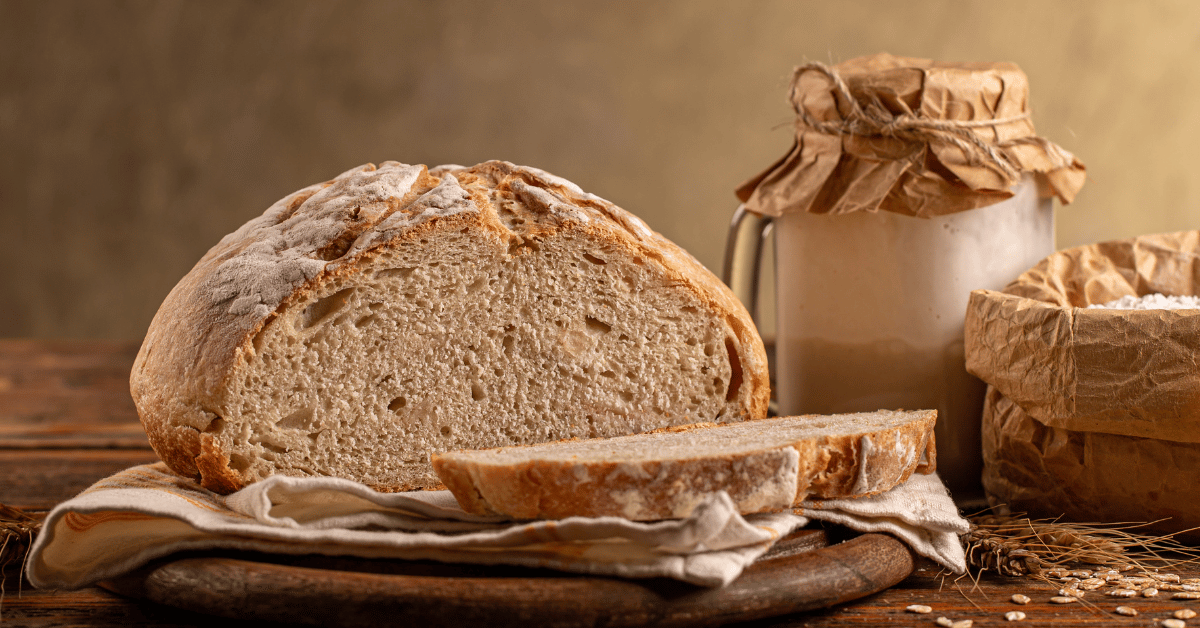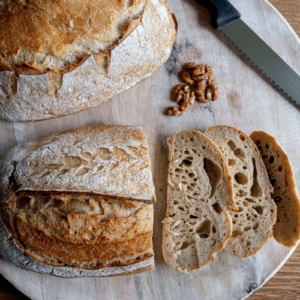Sourdough Bread Recipe Without Starter:

Discover a wholesome and easy-to-make Organic Sourdough Bread Recipe Without Starter designed for two people. This recipe uses a blend of organic whole wheat and rye flours, enhanced with coconut sugar and coconut oil for a naturally rich flavor. Perfect for those seeking a healthier, homemade bread option, this recipe is free from artificial ingredients and requires no sourdough starter. With simple steps and minimal effort, you can enjoy a delicious loaf that’s both nutritious and satisfying. Ideal for any meal, this organic bread is a must-try for home bakers looking for quality and simplicity.

Sourdough Bread Recipe Without Starter
Ingredients
- 250 gram Organic whole wheat flour (about 2 cups)
- 1 tbsp Organic coconut sugar
- 50 gram Organic rye flour (about ⅓ cup)
- 1/2 tbsp Himalayan salt
- 1 tbsp Active dry yeast
- 220 ml Filtered water
- 1 Organic coconut oil (melted, optional)
Instructions
- Mix the Dry Ingredients:In a large mixing bowl, combine the organic whole wheat flour, organic rye flour, coconut sugar, Himalayan salt, and active dry yeast. Stir well to ensure the ingredients are evenly distributed.
- Incorporate the Wet Ingredients:Gradually pour the warm filtered water into the dry mixture. If using, add the melted organic coconut oil at this stage. Use a wooden spoon or your hands to combine the ingredients until a rough dough forms. The dough should be moist but not overly sticky.

- Initial Rise:Cover the bowl with a clean, damp kitchen towel or plastic wrap. Place it in a warm, draft-free area, and let the dough rise for 4-5 hours until it doubles in size.

- Shape the Dough:Once the dough has risen, lightly flour a clean surface. Turn the dough out onto the surface and gently press it down to remove excess air. Fold the dough over itself a few times to form a ball, being careful not to overwork it.
- Second Rise:Line a small bowl with parchment paper and lightly dust it with flour. Place the dough ball inside, cover it again with a damp towel, and let it rise for another 1-2 hours until it has puffed up slightly.
- Preheat the Oven:Preheat your oven to 230°C (450°F) and place a small baking dish filled with water on the bottom rack to create steam. This will help achieve a crispy crust on your bread.

- Baking the Bread:Carefully transfer the dough, still on the parchment paper, onto a baking sheet or directly onto a preheated baking stone if you have one. Use a sharp knife to make a few shallow slashes on the top of the dough. Bake the bread for 25-30 minutes, until the crust is golden brown and the bread sounds hollow when tapped on the bottom.

- Cool and Serve: Remove the bread from the pot and let it cool on a wire rack for at least 1 hour before slicing. Enjoy your homemade organic sourdough bread!
No Starter Sourdough Bread Recipe with Yeast
For a tangy sourdough flavor without a starter, use a blend of whole wheat and rye flour with a small amount of active dry yeast. This recipe allows you to enjoy the rich taste of sourdough with minimal effort. If you ferment the dough overnight, you’ll develop a deep flavor profile similar to traditional sourdough. My Organic Sourdough Bread Recipe Without the Starter above uses yeast for a quick rise and delivers delicious results.
No Starter Sourdough Bread Recipe Overnight
Creating sourdough bread without a starter is possible by allowing the dough to ferment overnight. This slow fermentation process enhances the flavors, giving your bread a slightly tangy taste. You can prepare a delicious loaf with just a few organic ingredients, like whole wheat and rye flour, and a touch of yeast. My overnight recipe for Organic Sourdough Bread Without a Starter ensures a flavorful, wholesome bread ready to bake the next day.
Easy No Starter Sourdough Bread Recipe
Making sourdough bread without a starter doesn’t have to be complicated. My recipe combines organic flour, yeast, and minimal ingredients to create a simple yet flavorful loaf. This easy recipe requires little effort while delivering a delicious sourdough-like taste. It’s perfect for beginners looking to enjoy homemade bread with minimal fuss.
Best No Starter Sourdough Bread Recipe
If you’re searching for the best no starter sourdough bread recipe, look no further. My Organic Sourdough Bread Recipe Without Starter is a combination of whole wheat and rye flour to provide a rich, earthy flavor. By utilizing a small amount of yeast and a long fermentation process, this recipe above replicates the complexity of traditional sourdough.
Healthy No Starter Sourdough Bread Recipe
For a nutritious twist on traditional sourdough, my healthy no starter sourdough bread recipe above is the perfect choice. It uses organic whole wheat and rye flour, which are rich in fiber and nutrients. This bread is made without a starter, relying on yeast and a slow fermentation process to develop a sourdough-like flavor. Enjoy a wholesome, easy-to-digest loaf that’s delicious and beneficial for your health.
No-Knead Sourdough Bread Without Starter
No-knead sourdough bread without a starter is an easy and stress-free way to bake at home. You can skip the kneading process entirely by using a blend of organic flours and allowing the dough to ferment slowly. This method naturally lets the dough develop a strong gluten structure, resulting in a soft, chewy interior and a crisp crust.
Frequently asked questions:
Does sourdough bread require a starter?
Traditional sourdough bread does require a starter, which is a mixture of flour and water fermented with wild yeast and bacteria. However, you can make sourdough-like bread using commercial yeast or other pre-ferments to achieve a similar texture and flavor without a starter.
Is sourdough starter just flour and water?
Yes, a basic sourdough starter is made from just flour and water. Over time, natural yeast and beneficial bacteria from the environment ferment this mixture, creating the distinctive tangy flavor and leavening power that characterize sourdough bread.
Can I use yeast instead of sourdough starter?
Yes, you can use active dry yeast instead of a sourdough starter. While yeast won’t provide the same complex flavor as a traditional sourdough starter, it will help your bread rise effectively. You can also enhance the flavor by adding a small amount of vinegar or yogurt to mimic the tanginess of sourdough.
How to get sourdough taste without starter?
To achieve a sourdough-like taste without a starter, try adding a bit of yogurt, vinegar, or buttermilk to your dough. These ingredients can replicate the tangy flavor of sourdough. Additionally, using a long, slow fermentation process with a poolish or biga can enhance the bread’s flavor profile.
What is a substitute for sourdough starter?
A good substitute for sourdough starter is a poolish or biga, which are pre-ferments made from flour, water, and a small amount of yeast. These mixtures develop a tangy flavor and can be used in place of a traditional starter to make bread with a similar taste and texture.
What can I use instead of sourdough starter?
If you don’t have a sourdough starter, you can use active dry yeast as a substitute. While it won’t provide the same depth of flavor, it’s an effective alternative for making bread rise. Another option is a poolish or biga, which are pre-ferments made with flour, water, and a small amount of yeast, giving your bread a slight tang similar to sourdough.
Does sourdough require a starter?
Yes, authentic sourdough requires a starter, which is a fermented mixture of flour and water. However, if you don’t have a starter, you can still make bread with a sourdough-like flavor using alternatives like yeast and pre-ferments.
Can I use dry yeast instead of sourdough starter?
Yes, dry yeast can be used instead of a sourdough starter. While the resulting bread may not have the same depth of flavor as sourdough, you can still achieve a tasty and well-risen loaf.
Can I start my sourdough starter with all-purpose flour?
Yes, you can start a sourdough starter with all-purpose flour. It’s a versatile option that works well for cultivating the natural yeast and bacteria needed for sourdough. As your starter matures, you can switch to whole wheat or rye flour to add more nutrients and flavor.
